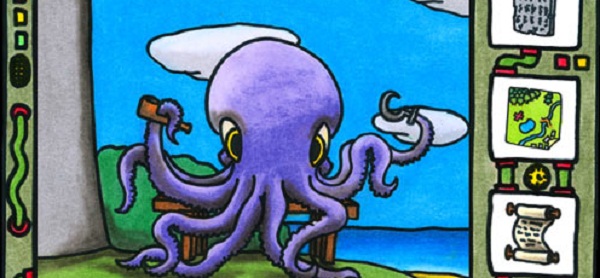 |
| It's small and cute. |
Our Ouya arrived yesterday! Acius had to do some display wizardry with the TV to get the resolution right, but other than that it was pretty easy to set up. It's definitely running on Android! And anyone can develop a game on it for free! I love the graphic design of the Ouya UI so far--sans serif fonts with logical category names that don't have too many subcategories.
The controller came out pretty well. The batteries are actually in the handles, which feels both clever and kind of a pain to replace. The analog sticks work wonderfully, but I'm wishing the D-pad were more precise. I'm not sure why, but the D-pad doesn't always do what my fingers tell it to. I'm hoping there's some sort of pattern to the madness that I'll get used to.
There aren't that many games yet, but I played a few so I thought I'd give 'em some blurbs. All games on the Ouya have some sort of playable demo or trial; trying them is free! :-)
Favorites so far:
 |
| before Acius fixed the display it looked too large. Also, Harry Potter road trip! |
The good:
Organ Trail gives me some nostalgia and makes me snicker like a 6th-grader. I love simulation games (yes, it is a zombie version of
Oregon Trail), and so far the zombies aren't too scary (I didn't get very far though, since their trial is timed... I might buy it). There's also some real strategy going on with what kinds of provisions to take along and when to go searching for stuff.
I played the demo for
Puddle a while ago on my Vita. It's a physics-based game where you're tilting liquid around to avoid obstacles and whatnot. I thought it was too hard then. I found it easier on the Ouya since you can only tilt so far.
Platformers are easy to make but hard to make well.
League of Evil starts out with fun things like double and wall jumps and has kind of a
Super Meatboy vibe to it. Playing this game actually made me want to get out my Vita and play some more
Guacamelee, since I felt like the platforming was tighter there. It's hard to tell if it's the game or the controller who is letting me down here, but it's still fun.
The maybe-you-will-like them:
Abbigale and the Monster: a cute puzzle game that does the two-player-characters-mirrored-who-have-one-control thing. I found it frustratingly difficult, but I liked the aesthetic (simple pixel art) and music.
The Ball bills itself as a FPS puzzle game. Admittedly I didn't get too far but I really didn't like the horror vibe going on. I think it was the music and the skulls, and the promise of enemies later, but it turned me into a chicken. It feels like it's missing little things like foot noises and good voice acting.
No Brakes Valet is a silly, simple car manipulation game. Cars come into the parking lot at breakneck speed, and you have to slow them down and park them for tips. Difficult.
The things-need-to-change games:
Polarity is another FPS puzzle game and its puzzle rooms remind me of
Portal. I want to like it but something is a little off about some of the physics. I should come back to it, since I like puzzle games, but I have some other more polished FPS puzzle games to finish.
Vector is a Parkour game the looks pretty sharp. You do things like jump, speed up, or duck depending on your environment. I think it has some in-app purchases, which rub me the wrong way (I much preferred
Organ Trail's timed demo).
Maybe I'm being too harsh a critic on these mostly indie games. I feel like with Steam sales being what they are, indie games have to compete with professional studio games, and to do that they should offer something another game isn't already doing better. I'd love to see more games with an engaging, semi-branching story, although I know that the target demographic for Ouya games is probably the more "hardcore" set that people assume just wants platformers and shoot 'em ups. Anyway, I'm excited to see what other games crop up for the Ouya (and also relieved that Ouya made good on their Kickstarter promise).
For those of you still waiting on your Ouya--I got my "it's on its way!" e-mail about 17 days ago. After two weeks I was going to e-mail them, since my tracking number wasn't working, but it turned out it actually was in the mail.










